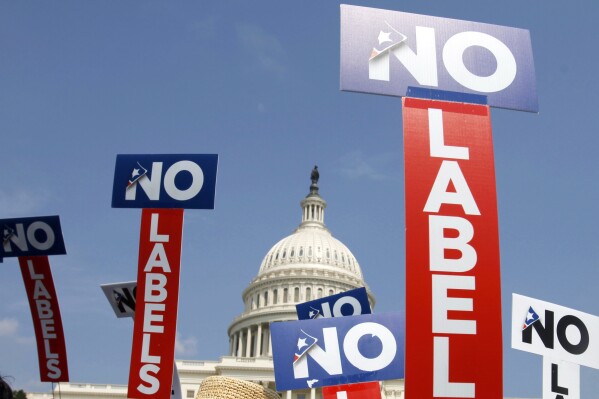Utah and Arizona will pay to keep national parks open if federal government shutdown occurs
PHOENIX (AP) — Arizona and Utah will keep iconic national parks in those states open if a shutdown of the federal government threatens access to Arizona’s orange-striped Grand Canyon and the sheer red cliffs of Utah’s Zion Valley.
Most importantly for state budgets, visitors can keep spending their money near the parks.
A cutoff could come Sunday. The economic impact of the national parks is so important that Arizona’s Democratic governor and Utah’s Republican governor have decided to invest state funds in keeping Grand Canyon, Zion, Arches, Bryce Canyon, Capitol Reef and Canyonlands national parks open.
For Arizona Gov. Katie Hobbs and Utah Gov. Spencer Cox, it’s a simple question of economics.
 Arizona says No Labels must accept all candidates even if the third party’s leadership opposes them
Arizona says No Labels must accept all candidates even if the third party’s leadership opposes them
 No. 7 Washington faces Arizona in the Huskies’ first Pac-12 road game of the season
No. 7 Washington faces Arizona in the Huskies’ first Pac-12 road game of the season
 No. 7 Washington and red-hot QB Penix hoping to avoid letdown on the road against Arizona
No. 7 Washington and red-hot QB Penix hoping to avoid letdown on the road against Arizona
The nonprofit National Parks Conservation Association says that every $1 invested in the National Park Service annually supports more than $15 in economic activity.
The association says that every day of a shutdown could mean national parks collectively losing nearly 1 million visitors, and gateway communities losing as much as $70 million.
Hobbs and Cox say their states will pay to keep those parks operating on a basic level, cushioning tourism-dependent communities.
“We expect to be reimbursed, just as federal employees receive back pay during a shutdown, and we have communicated this to the Department of Interior,” Cox said this week.
Hobbs has said Arizona Lottery funds would help keep the Grand Canyon park open.
Utah paid about $7,500 daily during the last part of December 2018 to keep Zion, Bryce Canyon and Arches running during a shutdown back then. The nonprofit Zion Forever Project committed $16,000 to pay a skeleton crew and keep bathrooms and the visitor center open at Zion, which continued drawing several thousand visitors daily.
The National Parks Conservation Association noted that keeping parks open during a shutdown without sufficient staff and other resources can be disastrous.
“We witnessed unnecessary and avoidable damage, including overflowing trash and human waste, vandalism, looting and illegal use of off-road vehicles,” the organization said about some sites during the 2018-2019 shutdown.
Conditions at Joshua Tree National Park in California were described as especially bad, with overflowing trash and portable toilets and unsupervised visitors driving off road and toppling incalculable numbers of the distinctive plants.
Sen. John Barrasso, a Republican representing Wyoming, on Thursday urged Interior Secretary Deb Haaland to keep the parks open with previously collected fees. The decision by Trump administration officials to use such fees to keep some parks open five years ago has been lambasted as illegal by the Government Accountability Office, the congressional watchdog.
The Interior Department and the National Park Service it oversees have not released a contingency plan for a probable shutdown.
“As secretary of the Interior, it is your responsibility to provide opportunities for people to access our parks in a way that ensures visitor health and safety, as well as providing the same opportunity for future generations,” wrote Barrasso, ranking member of the Senate Committee on Energy and Natural Resources.
Arizona paid about $64,000 a week during the shutdown that stretched 35 days from late 2018 to early 2019 to cover restroom cleaning, trash removal and snow plowing at the Grand Canyon park. People with permits to hike in the backcountry or raft on the Colorado River could still go, but no new permits were issued during that period.
National park employees who were not furloughed had to work without pay, their lost wages repaid after a budget resolution was reached.
Those expected to work in another potential shutdown include members of Grand Canyon National Park’s emergency services, which has teams trained in medical services, search and rescue and firefighting to protect not only visitors but about 2,500 park workers, concession employees and others who live on park property.
Joëlle Baird, the park’s public affairs specialist, said Arizona state funding “kept most everything business as usual” during the shutdown five years ago. She said hotels and restaurants remained open.
John Garder, senior director of Budget & Appropriations for the nonprofit National Parks Conservation Association, said funding the parks is a federal responsibility that states shouldn’t have to assume.
“We understand states’ interest in opening our parks when the government shuts down as they are proven economic engines, generating more than $50.3 billion and supporting more than 378,400 jobs annually,” Garder said. “But ultimately, it is Congress’ responsibility to keep them funded and open.”
The association said the shutdown could affect more than 400 sites in 50 states, the District of Columbia, and U.S. territories such as Puerto Rico, Guam and American Samoa.
In South Dakota, Gov. Kristi Noem was reviewing a shutdown’s possible impact on national parks, including Mount Rushmore, which Noem spokesperson Ian Fury called “the heart of South Dakota’s tourism industry.”
Colorado Gov. Jared Polis issued an executive order Thursday directing the state’s Department of Natural Resources to develop a plan for continued operations and resource protection of Colorado’s national parks. Rocky Mountain and the state’s other three national parks contributed $804 million to the local economy last year.
In Washington state, home to Mount Rainier and Olympic national parks, Gov. Jay Inslee has no plans to provide more funding or staff to national parks if there’s a shutdown. Inslee’s staff said much of governor’s discretionary spending was needed this year for cleanup and recovery after wildfires in Spokane County.
Montana Gov. Greg Gianforte’s office didn’t say if the state would spend money to keep Glacier or Yellowstone national parks open. But his staff said the Republican governor’s budget team is working with state agencies “to prepare for a possible shutdown in the event Congress can’t get its act together.”
Most of Yellowstone is in Wyoming, but three of the five entrances are in Montana.
Wyoming Gov. Mark Gordon is awaiting more information from Interior and White House officials to better understand the state’s options, spokesperson Michael Pearlman said.
Pearlman said the Republican governor was also in contact with officials at Grand Teton and Yellowstone national parks, recognizing that closures “could have significant economic repercussions to Wyoming families that live and work in our gateway communities.”
Democratic California Gov. Gavin Newsom’s administration said this week it doesn’t plan to keep national parks open if the federal government shuts down, saying they are not within state jurisdiction and the state has had to make difficult budgetary decisions this year.
___
Associated Press writers Ed Komenda in Olympia, Washington; Amy Beth Hanson in Helena, Montana; Matthew Brown in Billings, Montana; Jesse Bedayn in Denver; Tran Nguyen in Sacramento; and Matthew Daly in Washington contributed to this report.
Disclaimer: The copyright of this article belongs to the original author. Reposting this article is solely for the purpose of information dissemination and does not constitute any investment advice. If there is any infringement, please contact us immediately. We will make corrections or deletions as necessary. Thank you.




